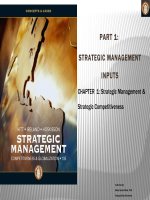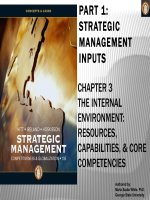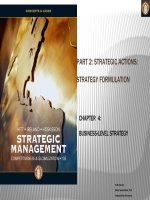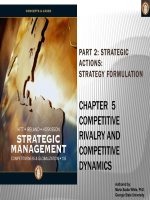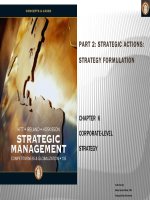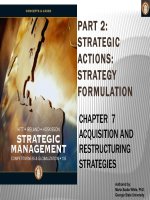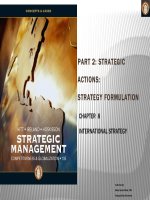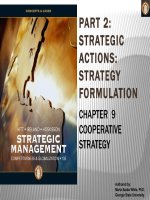Chapter 1 strategic management competitiveness and globalization 10e
Bạn đang xem bản rút gọn của tài liệu. Xem và tải ngay bản đầy đủ của tài liệu tại đây (960.07 KB, 74 trang )
PART 1:
STRATEGIC MANAGEMENT
INPUTS
CHAPTER 1: Strategic Management &
Strategic Competitiveness
Authored by:
Marta Szabo White. Ph.D
Georgia State University
THE STRATEGIC MANAGEMENT PROCESS
FIGURE 1.1
The Strategic
Management Process
©2013 Cengage Learning. All Rights Reserved. May not be copied, scanned, or duplicated, in whole or in part, except for use as permitted in a license distributed with a certain product or service or otherwise on a passwordprotected website for classroom use.
KNOWLEDGE OBJECTIVES
● Define strategic competitiveness, strategy, competitive
advantage, above-average returns, and the strategic
management process.
● Describe the competitive landscape and explain how
globalization and technological changes shape it.
● Use the industrial organization (I/O) model to explain how firms
can earn above-average returns.
● Use the resource-based model to explain how firms can earn
above-average returns.
©2013 Cengage Learning. All Rights Reserved. May not be copied, scanned, or duplicated, in whole or in part, except for use as permitted in a license distributed with a certain product or service or otherwise on a passwordprotected website for classroom use.
KNOWLEDGE OBJECTIVES
● Describe vision and mission and discuss their value.
● Define stakeholders and describe their ability to influence
organizations.
● Describe the work of strategic leaders.
● Explain the strategic management process.
©2013 Cengage Learning. All Rights Reserved. May not be copied, scanned, or duplicated, in whole or in part, except for use as permitted in a license distributed with a certain product or service or otherwise on a passwordprotected website for classroom use.
IMPORTANT DEFINITIONS
● STRATEGIC COMPETITIVENESS - achieved when a firm
successfully formulates and implements a value-creating strategy
● STRATEGY - an integrated and coordinated set of commitments and
actions designed to exploit core competencies and gain a competitive
advantage
● COMPETITIVE ADVANTAGE - when a firm implements a strategy
that creates superior value for customers; competitors are unable to
duplicate it or find too costly to imitate it
©2013 Cengage Learning. All Rights Reserved. May not be copied, scanned, or duplicated, in whole or in part, except for use as permitted in a license distributed with a certain product or service or otherwise on a passwordprotected website for classroom use.
IMPORTANT DEFINITIONS
● RISK -
an investor’s uncertainty about the economic gains or losses
that will result from a particular investment
● ABOVE-AVERAGE RETURNS - returns in excess of what an
investor expects to earn from other investments with a similar amount of
risk
● AVERAGE RETURNS -
returns equal to those an investor expects
to earn from other investments with a similar amount of risk
©2013 Cengage Learning. All Rights Reserved. May not be copied, scanned, or duplicated, in whole or in part, except for use as permitted in a license distributed with a certain product or service or otherwise on a passwordprotected website for classroom use.
OPENING CASE
ONCE A “GIANT,” BORDERS BECAME A “WEAKLING” ON ITS KNEES
INABILITY TO EARN AVERAGE RETURNS resulted first in decline and,
eventually, failure
BORDERS - OPENING CASE - FAILURE EXAMPLE
●Enjoyed considerable success early on
●Tried to enrich its traditional approach with more marketing and more attractive stores,
demonstrating a lack of market understanding
● Declining book sales for large chain store retailers
●Should have been entrepreneurial, innovative, and market-oriented
©2013 Cengage Learning. All Rights Reserved. May not be copied, scanned, or duplicated, in whole or in part, except for use as permitted in a license distributed with a certain product or service or otherwise on a passwordprotected website for classroom use.
THE STRATEGIC MANAGEMENT
■ FIRST:
PROCESS
External environment and internal organization are analyzed to determine resources,
capabilities, and core competencies—the sources of “strategic inputs.”
■ NEXT:
Vision and mission are developed; strategies are formulated.
■ THEN:
Strategies are implemented with the goal of achieving strategic competitiveness and
above-average returns.
■ DYNAMIC PROCESS:
Continuously changing markets and industry conditions must
match evolving strategic inputs.
©2013 Cengage Learning. All Rights Reserved. May not be copied, scanned, or duplicated, in whole or in part, except for use as permitted in a license distributed with a certain product or service or otherwise on a passwordprotected website for classroom use.
THE STRATEGIC MANAGEMENT
PROCESS
Rational: the approach firms use to achieve strategic competitiveness
and earn above-average returns
FORMULATION and IMPLEMENTATION:
the two types of strategic actions that must be simultaneously integrated to
successfully employ the strategic management process
©2013 Cengage Learning. All Rights Reserved. May not be copied, scanned, or duplicated, in whole or in part, except for use as permitted in a license distributed with a certain product or service or otherwise on a passwordprotected website for classroom use.
THE STRATEGIC MANAGEMENT
•
PROCESS
Chapters
Chapters
2,
2, 3
3
Vision/Mission
Vision/Mission
text
e
h
T
i nt o
d
e
vid
is di
.
a rt s
p
e
thre
•
Chapters
Chapters
4,
PART
4, 5,
5,
PART I:
I: STRATEGIC
STRATEGIC INPUTS
INPUTS
6,
6, 7,
7, 8
8&
&9
9
PART
PART II:
II: STRATEGIC
STRATEGIC ACTIONSACTIONSSTRATEGY
STRATEGY FORMULATION
FORMULATION
Chapters
PART
ACTIONSPART III:
III: STRATEGIC
STRATEGIC Chapters
ACTIONS-
•
10,
STRATEGY
10, 11,
11,
STRATEGY IMPLEMENTATION
IMPLEMENTATION
12
12 &
& 13
13
©2013 Cengage Learning. All Rights Reserved. May not be copied, scanned, or duplicated, in whole or in part, except for use as permitted in a license distributed with a certain product or service or otherwise on a passwordprotected website for classroom use.
THE COMPETITIVE LANDSCAPE
■ GLOBALIZATION - emergence of a global economy
■ TECHNOLOGY - rapid technological changes
■ INDUSTRY BOUNDARIES BLURRING
■ EXAMPLES - computer networks and telecommunications have blurred the boundaries
of the entertainment industry
■ MSNBC is co-owned by NBC Universal and Microsoft
■ General Electric owns 49 percent of NBC Universal and Comcast owns the remaining
51 percent
■ STRATEGIC MANAGEMENT PROCESS - effective use of the strategic management
process reduces the likelihood of failure for firms as they encounter the conditions of today’s
competitive landscape
©2013 Cengage Learning. All Rights Reserved. May not be copied, scanned, or duplicated, in whole or in part, except for use as permitted in a license distributed with a certain product or service or otherwise on a passwordprotected website for classroom use.
THE COMPETITIVE LANDSCAPE
■ HYPERCOMPETITION - characterized by
■ Market instability and change
■ Rapidly escalating competition
■ Aggressive challengers
■ Strategic maneuvering to establish first-
mover
advantage
■ Technology industries
■ TWO DRIVERS
- GLOBALIZATION
- TECHNOLOGY
■ Strategic flexibility - important tool
©2013 Cengage Learning. All Rights Reserved. May not be copied, scanned, or duplicated, in whole or in part, except for use as permitted in a license distributed with a certain product or service or otherwise on a passwordprotected website for classroom use.
THE COMPETITIVE LANDSCAPE
THE GLOBAL ECONOMY
■
Goods, services, people, skills, and ideas move freely
across geographic borders
■
New opportunities and challenges emerge
■
Competitive environments are broader and increasingly
more complex
©2013 Cengage Learning. All Rights Reserved. May not be copied, scanned, or duplicated, in whole or in part, except for use as permitted in a license distributed with a certain product or service or otherwise on a passwordprotected website for classroom use.
THE COMPETITIVE LANDSCAPE
THE GLOBAL ECONOMY
■
The European Union has become one of the world’s
largest markets, with 700 million potential customers
■
China has become the second largest economy in the
world surpassing Japan
■
India, the world’s largest democracy, has an economy
that now ranks as the fourth largest in the world
©2013 Cengage Learning. All Rights Reserved. May not be copied, scanned, or duplicated, in whole or in part, except for use as permitted in a license distributed with a certain product or service or otherwise on a passwordprotected website for classroom use.
THE COMPETITIVE LANDSCAPE
STRATEGIC FOCUS
Huawei also needs Guanxi in the United
States
GUANXI
■ Strong relationships in which each party feels obligated to help
the other
■ Key element of doing business in China
■ Building strong relationships is an important dimension of
Chinese culture; Guanxi is also important when conducting business
in the United States
©2013 Cengage Learning. All Rights Reserved. May not be copied, scanned, or duplicated, in whole or in part, except for use as permitted in a license distributed with a certain product or service or otherwise on a passwordprotected website for classroom use.
THE COMPETITIVE LANDSCAPE
THE GLOBAL ECONOMY
■ Hypercompetitive business environment challenges firms to reconsider
which markets to compete in; this positioning is more critical than ever
■ GE - headquartered in the U.S., yet up to 60% of its revenue growth through
2015 will be generated from rapidly developing economies such as China and
India
■ Jeffrey Immelt - suggests that we have entered a new economic era in
which the global economy will be more volatile and emerging economies such
as Brazil, China, and India will be the major drivers of growth
©2013 Cengage Learning. All Rights Reserved. May not be copied, scanned, or duplicated, in whole or in part, except for use as permitted in a license distributed with a certain product or service or otherwise on a passwordprotected website for classroom use.
THE COMPETITIVE LANDSCAPE
THE MARCH OF GLOBALIZATION
Globalization is increasing economic
interdependence among countries
and their organizations as reflected
in the flow of goods and services,
financial capital, and knowledge
across country borders.
Globalization is the product of a
Highly globalized firms must
large number of firms competing
anticipate ever-increasing
against one another in an
complexities in their operations as
increasing number of global
goods, services, people, etc. move
economies.
freely across geographic borders.
©2013 Cengage Learning. All Rights Reserved. May not be copied, scanned, or duplicated, in whole or in part, except for use as permitted in a license distributed with a certain product or service or otherwise on a passwordprotected website for classroom use.
THE COMPETITIVE LANDSCAPE
THE MARCH OF GLOBALIZATION
Globalization has led to higher
performance standards in quality,
cost, productivity, product
introduction time, and operational
efficiency. These standards translate
and impact domestic-only firms as
well.
Free flow of resources among global
Firms must learn that in this twenty-
economies, global sourcing for firms,
first century competitive landscape,
global purchasing for customers, and
only firms capable of meeting, if not
a global forum for workers all serve
exceeding, global standards, have
as a key source of competitive
the capability to earn above-average
advantage for firms.
returns.
©2013 Cengage Learning. All Rights Reserved. May not be copied, scanned, or duplicated, in whole or in part, except for use as permitted in a license distributed with a certain product or service or otherwise on a passwordprotected website for classroom use.
THE COMPETITIVE LANDSCAPE
THE RISKS OF GLOBALIZATION
Significant time is required for firms
With globalization, firms may over-
to learn how to compete in new
diversify internationally, which can
markets, and performance may
have strong negative effects on a
suffer during this time.
firm’s overall performance.
It is critical for firms competing
globally to remain strategically
committed to and competitive in
both domestic and international
markets.
©2013 Cengage Learning. All Rights Reserved. May not be copied, scanned, or duplicated, in whole or in part, except for use as permitted in a license distributed with a certain product or service or otherwise on a passwordprotected website for classroom use.
THE COMPETITIVE LANDSCAPE
TECHNOLOGY AND TECHNOLOGICAL CHANGES
THREE CATEGORIES for TECHNOLOGY TRENDS
Technology is significantly altering the nature of competition and enabling unstable competitive
environments
■Technology Diffusion & Disruptive Technologies
■ Information Age
■ Increasing Knowledge Intensity
©2013 Cengage Learning. All Rights Reserved. May not be copied, scanned, or duplicated, in whole or in part, except for use as permitted in a license distributed with a certain product or service or otherwise on a passwordprotected website for classroom use.
THE COMPETITIVE LANDSCAPE
TECHNOLOGY AND TECHNOLOGICAL CHANGES
Technology Diffusion - Category 1
■ Technology Diffusion – the speed at which new technologies become
available and are used; has increased substantially over the past 15 to 20 year.
■ Examples of technology diffusion: How long it took to get the following into
25 percent of U.S. homes:
● Telephone — 35 years
● TV — 26 years
● Radio — 22 years
● PCs — 16 years
● Internet — 7 years
©2013 Cengage Learning. All Rights Reserved. May not be copied, scanned, or duplicated, in whole or in part, except for use as permitted in a license distributed with a certain product or service or otherwise on a passwordprotected website for classroom use.
THE COMPETITIVE LANDSCAPE
TECHNOLOGY AND TECHNOLOGICAL CHANGES
Technology Diffusion - Category 1
Perpetual Innovation
■ Perpetual Innovation - describes how rapidly and consistently new,
information-intensive technologies replace older ones
■ Competitive Premium - the shorter product life cycles resulting from rapid
diffusions of new technologies place a competitive premium on being able to
quickly introduce new, innovative goods and services
■ Competitive Advantage - speed to market with innovative products is a
primary source of competitive advantage
©2013 Cengage Learning. All Rights Reserved. May not be copied, scanned, or duplicated, in whole or in part, except for use as permitted in a license distributed with a certain product or service or otherwise on a passwordprotected website for classroom use.
THE COMPETITIVE LANDSCAPE
TECHNOLOGY AND TECHNOLOGICAL CHANGES
Technology Diffusion - Category 1
Perpetual Innovation
■ Innovations must be derived from an understanding of global standards and
global expectations in terms of product functionality
■ Apple - an excellent example of radical innovation by a large established firm
■ Technology Diffusion - to diffuse the technology and enhance the innovation
value, firms need to be innovative in incorporating the new technology into their
product
©2013 Cengage Learning. All Rights Reserved. May not be copied, scanned, or duplicated, in whole or in part, except for use as permitted in a license distributed with a certain product or service or otherwise on a passwordprotected website for classroom use.
THE COMPETITIVE LANDSCAPE
TECHNOLOGY AND TECHNOLOGICAL CHANGES
Technology Diffusion - Category 1
Perpetual Innovation
■ Rapid Technology Diffusion - now may take only 12 to 18 months for firms to
gather information about research and development and product decisions for their
competitors
■ Patents - may be an effective protection of proprietary technology in a small
number of industries, e.g., pharmaceuticals
■ Proprietary Strategies - many firms often do not apply for patents to prevent
competitors from gaining access to the technological knowledge included in the patent
application, e.g., the electronics industry
©2013 Cengage Learning. All Rights Reserved. May not be copied, scanned, or duplicated, in whole or in part, except for use as permitted in a license distributed with a certain product or service or otherwise on a passwordprotected website for classroom use.
THE COMPETITIVE LANDSCAPE
TECHNOLOGY AND TECHNOLOGICAL CHANGES
Technology Diffusion - Category 1
Disruptive Technologies
■ Disruptive Technologies - technologies that destroy the value of an existing
technology and create new markets, many times representing radical or breakthrough
innovation
■ Examples: iPods, iPads, WiFi, and the browser
■ Industry Incumbents Harmed or Destroyed – a disruptive or radical technology
creates a new industry, thereby destroying the existing industry; with superior
resources, experience, and access to the new technology, some incumbents may be
able to adapt
©2013 Cengage Learning. All Rights Reserved. May not be copied, scanned, or duplicated, in whole or in part, except for use as permitted in a license distributed with a certain product or service or otherwise on a passwordprotected website for classroom use.
